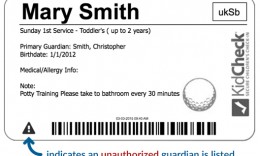Six Ways to Prioritize VBS Safety

This is the time of year when ministry teams begin ramping up for vacation bible school or VBS. VBS is a unique event that brings together a lot of new kids in a short time who probably don’t attend your weekly program. This can be a blessing and a curse from a child safety standpoint. Whether recruiting new volunteers, preparing budgets, or creating a promotional plan, child safety should be a top priority regardless of where you are in the planning process.
Implementing a safety plan or policies that focus on protection protocols is a good first step. This will help you attract new families, create a positive first impression, and recruit quality volunteers.
Here are six ways to prioritize child safety for VBS.
1. Establish Safety Goals
A safety goal ensures that children are protected, and it doesn’t have to be difficult or complicated. If you have a current child protection policy, you can pull what’s needed from the document. Safety goals set a foundation for how you intend to protect the children in your care, minimize the grey area for staff and volunteers when interacting with kids, and provide a layer of protection.
An example of this would be utilizing the Two Adult Rule, which is a preferred standard for abuse prevention during bathroom breaks or ensuring that children are never isolated or alone with an adult.
2. Be Prepared
Being prepared is the key to abuse prevention, and having a plan that’s easily understood, actionable, and communicated often is essential. Your core team of volunteers and staff should understand your organization’s commitment to safety and prevention. At a minimum, each person should know the details of how to report an incident, the location of first aid kits, who to call in an emergency, and which children have allergies and their respective reactions. This can be easily accomplished if you have a plan.
3. Wisely Choose Volunteers
This is very important! Many VBS programs need volunteers, so it feels like they’ll take anyone. You want to start recruiting early and focus on a core set of volunteers and staff who complete a full evaluation, known as the comprehensive candidate screening process. The screening process should include a background check, completed application, in-person interview, checked references, and social media review.
Once your core group is in place, assign them to evaluate other volunteers who wish to participate. The process should remain consistent for anyone coming into contact with children. Once the screening process is complete, you can determine people’s event assignments. If you have someone with a questionable background, you can either refer them to another area that doesn’t work with children or assign them to a role where they don’t have any direct access to kids.
4. Secure Your Facility
It’s important to keep activities in highly visible areas and maintain the appropriate child-to-volunteer ratio for each age group. If your activities are going to be outside, make sure the kids know where they can and can’t go. In some cases, it’s best to rope off the areas where they’re not allowed.
If you have questions about your facility’s safety, you can also contact your local first-response community, such as police and fire. They are always willing to come onsite and do a complimentary safety assessment of your location, which can help you determine what changes you’ll need to make.
5. Have a Check-In and Out Process
Having a well-thought-out, secure children’s check-in and checkout process is equally as significant as choosing the right volunteers. Whether using pen and paper or a digital solution, each child should be released only to those authorized to pick them up.
You’ll also want to have a process for managing health and wellness information. With the increase in childhood allergies, your team must know which children have allergies and their respective reactions. This will go a long way in helping to minimize any incidents.
6. Incident Management
In the case of an accident or an emergency, you’ll want to have a process for following up with everyone involved. Make sure you keep accurate records and incident photos in a secure location. If a child has been hurt or injured, provide care and contact the family immediately. If police need to be contacted, provide your full cooperation and in no way hinder that investigation.
Additional VBS Support
For additional VBS information, visit the KidCheck blog. If you’re a current KidCheck customer, click here to contact the sales department and add a temporary license or change additions to take advantage of the many features available to help meet VBS’s increased needs.
Click here to learn more about the benefits of using secure children’s and youth check-in to help manage your children’s area, keep families smiling, and improve child safety. You can also subscribe to the KidCheck blog or find us on YouTube, Twitter, Facebook, Pinterest, and Instagram.
Photo by Chris J. Davis on Unsplash


